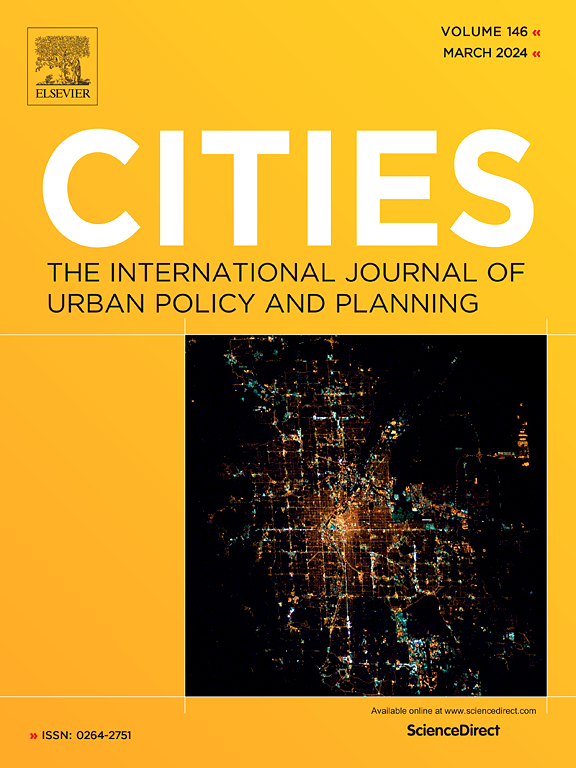Nationwide analysis of the association between nature park visits and adult asthma risk in urbanized neighborhoods
IF 6
1区 经济学
Q1 URBAN STUDIES
引用次数: 0
Abstract
Evidence linking greenspace to asthma remains mixed, largely because prior studies infer exposure from static land-cover maps rather than where people actually spend time. Here, we bridge that gap, conducting the first nationwide analysis to translate passively collected GPS traces into an “actual-use” nature park metric. This study used millions of visit records to 127,752 nature parks across the contiguous United States based on a large-scale dataset from GPS-enabled mobile devices to investigate the associations between nature park visits and adult asthma risk at the neighborhood level in urbanized areas. The exposure-response relationship derived from XGBoost-SHAP analysis shows that increasing park visits reduces asthma risk, but the protective effect plateaus when visits exceed 51.94 per year. Stratified by park visits, the second, third, and fourth quartiles of nature park visits were associated with a reduction in high asthma risk by 29 % (OR: 0.71, 95 % CI: 0.67–0.75), 46 % (OR: 0.54, 95 % CI: 0.51–0.57), and 65 % (OR: 0.35, 95 % CI: 0.33–0.37), respectively, compared to the first quartile. We further observed significant additive interactions between nature park visits and environmental factors on asthma risk, with high NDVI (Normalized Difference Vegetation Index) reducing asthma risk (AP = −0.1, 95 % CI: −0.19 to −0.01), while high urban heat island index (UHI) (AP = 0.56, 95 % CI: 0.49 to 0.64) and high PM2.5 levels (AP = 0.24, 95 % CI: 0.15 to 0.32) increased asthma risk. These findings highlight the importance of mobility-informed measures of nature park use, identify non-linear saturation effects, and demonstrate interactions with urban environmental stressors. Policymakers and urban planners should integrate human mobility patterns, environmental contexts, and equity considerations into greenspace strategies to effectively mitigate asthma risk and enhance respiratory health in urban settings.
全国范围内对自然公园访问与城市化社区成人哮喘风险之间关系的分析
将绿地与哮喘联系起来的证据仍然是混杂的,很大程度上是因为之前的研究是从静态的土地覆盖地图推断暴露,而不是人们实际花时间的地方。在这里,我们弥合了这一差距,进行了第一次全国性的分析,将被动收集的GPS轨迹转化为“实际使用”的自然公园指标。本研究基于基于gps功能的移动设备的大规模数据集,使用了美国相邻127752个自然公园的数百万次访问记录,以调查城市化地区社区自然公园访问与成人哮喘风险之间的关系。通过XGBoost-SHAP分析得出的暴露-反应关系表明,增加公园参观次数可降低哮喘风险,但当每年参观次数超过51.94次时,保护作用趋于稳定。通过公园访问分层,与第一个四分位数相比,自然公园访问的第二,第三和第四个四分位数分别与高哮喘风险降低29% (OR: 0.71, 95% CI: 0.67-0.75), 46% (OR: 0.54, 95% CI: 0.51-0.57)和65% (OR: 0.35, 95% CI: 0.33-0.37)相关。我们进一步观察到自然公园访问与环境因素对哮喘风险的显著加性相互作用,高NDVI(归一化植被指数)降低哮喘风险(AP = - 0.1, 95% CI: - 0.19至- 0.01),而高城市热岛指数(AP = 0.56, 95% CI: 0.49至0.64)和高PM2.5水平(AP = 0.24, 95% CI: 0.15至0.32)增加哮喘风险。这些发现强调了自然公园使用的流动性信息测量的重要性,确定了非线性饱和效应,并展示了与城市环境压力源的相互作用。决策者和城市规划者应将人类流动模式、环境背景和公平考虑纳入绿色空间战略,以有效减轻哮喘风险,增强城市环境中的呼吸系统健康。
本文章由计算机程序翻译,如有差异,请以英文原文为准。
求助全文
约1分钟内获得全文
求助全文
来源期刊

Cities
URBAN STUDIES-
CiteScore
11.20
自引率
9.00%
发文量
517
期刊介绍:
Cities offers a comprehensive range of articles on all aspects of urban policy. It provides an international and interdisciplinary platform for the exchange of ideas and information between urban planners and policy makers from national and local government, non-government organizations, academia and consultancy. The primary aims of the journal are to analyse and assess past and present urban development and management as a reflection of effective, ineffective and non-existent planning policies; and the promotion of the implementation of appropriate urban policies in both the developed and the developing world.
 求助内容:
求助内容: 应助结果提醒方式:
应助结果提醒方式:


